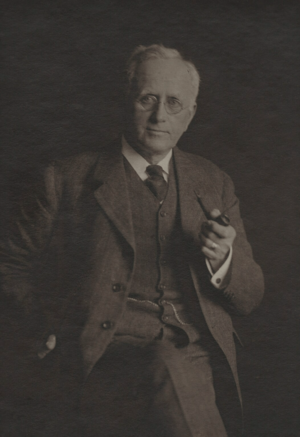Albert Seward facts for kids
Quick facts for kids
Albert Charles Seward
|
|
|---|---|
 |
|
| Born | 9 October 1863 |
| Died | 11 April 1941 |
| Nationality | British |
Sir Albert Charles Seward was a famous British scientist. He was a botanist, which means he studied plants, and a geologist, meaning he studied rocks and the Earth. He was especially known for his work on ancient plants, called palaeobotany.
A Life of Discovery
Albert Charles Seward was born in Lancaster, England, in 1863. When he was young, his parents wanted him to become a church minister. But Albert had a strong interest in plants and animals from a young age.
He went to St John's College, Cambridge, for his university studies. There, inspiring lectures from a professor named William Crawford Williamson helped him realize his passion for botany and zoology. He was very good at it!
In 1890, he became a lecturer in botany at Cambridge University. Later, he became a professor of botany, teaching students about plants from 1906 to 1936.
Seward spent a lot of time studying Mesozoic palaeobotany. This means he looked at fossilized plants from a very long time ago, during the age of dinosaurs. His amazing work earned him a special membership in the Royal Society when he was only 35 years old. The Royal Society is a group of very important scientists.
He also cared a lot about education. He worked as an administrator at the university and wrote about how to make education better. Besides ancient plants, he was also interested in the plant carvings found in old buildings, like the ones at Southwell Minster.
Sir Albert Charles Seward passed away in Oxford in 1941, at the age of 77.
His Family
Albert Charles Seward had a daughter who married one of his best students, John Walton. John Walton later became a professor of botany at Glasgow University. His father was a famous artist named Edward Arthur Walton.
Key Moments in His Life
- 1886 He began his career studying ancient plants (palaeobotany).
- 1890-1906 He worked as a lecturer in botany at Cambridge University.
- 1898 He became a member of the Royal Society of London.
- 1906-36 He served as the Professor of Botany at Cambridge.
- 1908 He received the Murchison Medal for his work in geology.
- 1915-36 He was the Master of Downing College, Cambridge.
- 1922-24 He was the President of the Geological Society of London.
- 1924-26 He served as the Vice-Chancellor of Cambridge University.
- 1925 He received the Royal Medal from the Royal Society.
- 1930 He received the Wollaston Medal from the Geological Society.
- 1931 He published a book called "Plant Life Through the Ages".
- 1934 He received the Darwin Medal from the Royal Society.
- 1936 He was given a special honor and became a Knight, so he was called "Sir Albert".
- 1939 He became the President of the British Association for the Advancement of Science.
See Also
- List of botanists by author abbreviation

